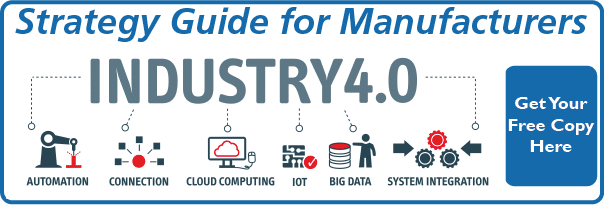Is it "Day 1" in your business?
Have you read Bezos' 2016 letter to shareholders? He cites three core principles that Amazon relies on to stay relevant.
- strong customer focus - essentially qualitative or 1:1 observation rather than quantitative, aggregated data; process should enable not constrict
- embrace external trends - you're not going to change them, shouldn't you build on them and enjoy the "tailwind"?
- good decisions, made quickly - you won't always agree, but you need to decide and move. You'll never have all the information. 70% is a benchmark he embraces
Many of the manufacturers I talk to balk at much of this in practice. In theory they agree it all sounds good. But when it's time to apply it to their company, well then there's plenty of "Well they're big enough to take risks." and "It's easy to adjust in software, we're a factory with machines and overhead."
That's a shame - because manufacturers are missing key opportunities.
In fact I would argue that two of the most important assets which will characterize the balance sheets of successful manufacturers in 5-7 years will be items that are rarely even listed now.
That doesn't require Ari Wallach's (@AriW) transgenerational future planning, but it does require a longer (and wider aperture opening) than most corporate strategy.
Data & revenue growth IP
Data as an asset
Let's tackle data first. Two often companies think of data in aggregate - and certainly the opportunity to mine insights is important. For instance, monitoring your website chat and discerning that lunchtime on Thursdays is the busiest time for incoming chats lets you staff accordingly.
Beyond that sort of aggregate insight, the real power in data lies in the individual insights - let's call it quasi qualitative - and the value to others. In the former is power to differentiate your company to buyers who increasingly expect personalized experience. The latter holds enormous potential as a monetizable asset.
But first companies have to overcome a mindset barrier. Capital equipment manufacturers think of themselves as machine builders. That involves software and interactions - but they see those as byproducts or tangential. That conflicts with the evolution of manufacturing which is increasingly about the data - and in which machines are essentially commoditized buckets of data collecting sensors.
 There's growing awareness of the power of data to help companies deepen and automate buyer relationships. If ever there was proof of this it is obvious in Kimberly Clark's wipe tracking IoT toilet paper roller. (h/t @DMScott for the heads-up on this.)
There's growing awareness of the power of data to help companies deepen and automate buyer relationships. If ever there was proof of this it is obvious in Kimberly Clark's wipe tracking IoT toilet paper roller. (h/t @DMScott for the heads-up on this.)
Think this one's just some sort of a joke? Think this sounds outlandish? Wal-Mart doesn't. Its October '16 patent filing that was just made public on May 5, 2017 speaks to precisely this trend. It will track your expiring milk and how many times you launder your jeans.
The data represents soooo much more however.
Let's just consider a few examples from the toilet paper roller.
- What if KC could provide data to septic services indicating when a pump was required - eliminating the need to track and schedule for consumers...who forget and then bear remediation and repair costs
- Or if they could help municipalities gauge when pumping substations would need to be serviced
- What if coupons printed by grocery stores reflected items not based on checkout history, but based on usage AND purchase history - lots of flushes but no recent TP purchase? Time to drop a coupon in there
 Or if you didn't have to ask Alexa to order it, or take a case on a calendar interval, because Amazon knew based on roll rotations and replacements when it was time
Or if you didn't have to ask Alexa to order it, or take a case on a calendar interval, because Amazon knew based on roll rotations and replacements when it was time- An opportunity to manage a bidding war (not just for a three year contract, but dynamically for every alert) between Amazon, Wal-Mart and upcoming services like Target's Restock
- What if property management firms could not only simplify operational logistics, but compare water use to flush/wash frequency to identify anomalies indicating water loss
- And what if Sheryl Crow could mechanically limit everyone to 3 squares (or track violations)
The point is clearly that the data could enable enormous commercial and operational efficiencies. In fact, the cover of the 6 May issue of The Economist speaks for itself. And therein lies a massive potential asset that could be monetized.
It will take time to accumulate the data - and there are privacy, anonymity and proprietary barriers to work through.
But capital equipment manufacturing companies (and their sales channel) that can make the mind shift from steel bending to data will have taken a huge step toward a 2020 manufacturing market strategy.
Revenue Growth IP
The other area is the process and expertise with which they grow.
Reconciling the dissonance between scientific management of manufacturing and cavalier approach to revenue growth process
Most industrial manufacturers think of their product IP as their most significant asset. For some it is. For many it's probably the building that they occupy and the future revenue stream of spare parts.
But for many it could become the IP around their revenue growth.
The simple fact is that most industrial manufacturing companies have invested enormous resources in optimizing their manufacturing operations...and on the revenue growth side they maybe hire another rep, attend another trade show, run another add, refresh a stale website, or really kick it up a notch and bring someone in to talk time management with their sales reps.
There's no analogous rigor focused on revenue growth and manufacturing market strategy.
And that's absurd given how buying habits have changed. Silos need to be busted and the revenue growth function needs to be integrated across PR, marketing, inside sales, field sales & customer service as outlined in this narrated 10 minute "picture book."
Building process & incorporating tools
On the manufacturing line when there's a defect, things stop. And they stay stopped until its cause is discovered and fixed.
One the sales side quotes are issued that everyone knows will never close...and nobody stops sales to understand why, much less change things.
There's an opportunity here. Part of it is mindset - simply viewing the revenue growth function as a process to be managed, improved and refined just as manufacturing operations. And part of it is data and tools. Product quality measures are very concrete - a part meets them or it's a defect. Traditionally revenue growth metrics were much more opaque.
That's changed - and while buyers are using the internet in ways that frustrate traditional sales methods, the good news is that same internet use enables revenue growth teams to understand and measure with much more accuracy what buyers are thinking and doing.
Content marketing, marketing automation, granular metrics & analytics and behavioral observation combine to provide the insights that are necessary to develop, implement, test and improve the demand generation, lead generation, sales and retention functions. These tools provide rich individual, qualititative data upon which good decisions are based.
Creating the IP
This process will create value in a number of ways.
But a quick clarification first - this "process" is different than the commonly used term "sales process." The latter is a critically important element of the revenue growth process opportunity, but it's only an element of it.
As companies use these tools, collect data and refine their process they will:
- sell more effectively because they'll match buyer needs and expectations
- predict with increasing accuracy which leads will actually buy, and when
- staff for functions and pay for success in ways which match business rather than legacy models
- improve outbound results with modeling
- refine forecasting to improve financial accuracy and production planning
Cumulatively this is a revolutionary change - every bit as significant as the shift in manufacturing operations to lean, JIT and quality.
This revenue growth IP will represent an enticing capability for which an acquirer would potentially pay more - an asset with value.
It will increase valuation in other ways as well.
- With accurate forecasting and a predictable, repeatable process for revenue growth, the future earnings will be more predictable and secure.
- Companies that take this approach will have significant data on prospect, customer and industry trends and behaviors. That buying behavioral data, distinct from the operational type noted above, will have value itself - separate from it's implications to the process and IP
- Privately held companies considering a liquidity event will be more comfortable accepting higher earn-out components because of their confidence in future earnings
Products get in the way
The reality for most industrial companies, however, is that their manufacturing market strategy is focused on products. That's the lens through which they see the world - they have market cataracts.
Products are merely the medium by which they improve customers outcomes - and it's the problems, known and unknown by prospects, on which attention must be focused.
Once that shift is made then they can begin to see their product roadmap in the context of disruption and envision opportunities to leverage the cloud, IoT and more - all around the data.
And they'll be able to reengineer their revenue growth process to improve outcomes.
Both result in assets with likely future value, and both represent enormous opportunities to leapfrog competition which remains fixated on incremental product improvements.
Can CEOs shift company mindset? Some will, just as some improved manufacturing operations in the US to compete globally. Of course, many will not.
Which are you?
“Intitum didium facti”; the start is half the deed.
Want to prime your brainstorming pump by exploring some of the disruptive trends that are going to shape industry over the next ten years? This free "Strategy Roadmap & Question Guide" is designed for boards and executive management teams to stimulate thought and discussion. Get your free copy here.



